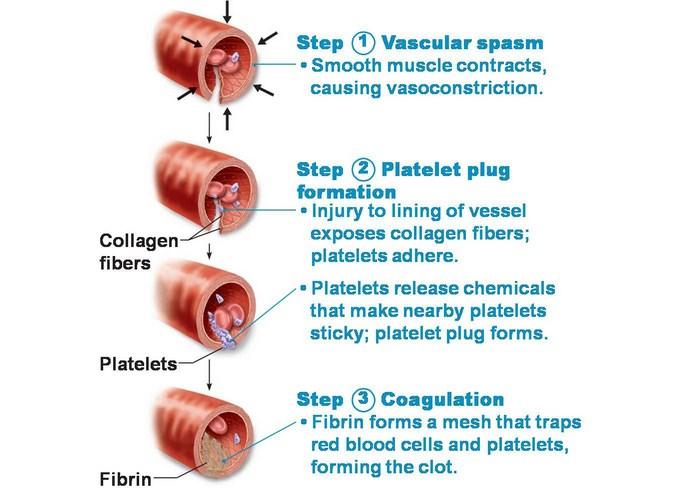
Hemostasis is a process in which the bleeding is arrested by the formation of clot. Clotting of blood is an enzymatic process, which involves various plasma clotting factors, leading to the conversion of fibrinogen to fibrin.
The clotting factors are plasma proteins, which exist in inactive proenzyme form. During the process of coagulation, each inactive proenzyme is converted into active enzyme form. This activated factor inturn, activates subsequent proenzyme clotting factors to finally result in fibrin (clot). The activation of clotting begins with the blood coming in contact with the rough surface and collagen of the damaged blood vessel. At each step in the activation of clotting factor, the reaction is amplified and is known as enzyme cascade mechanism. Broadly, the process of clotting can be described in three steps.
In the first step, the prothrombin activator is formed. It is generated in the intrinsic pathwaywithin the blood and also in the extrinsic pathway from the damaged tissues. This, in the next step activates prothrombin to thrombin. In the last step, the thrombin converts fibrinogen to fibrin.Though it appears as a simple process, the involvement of several clotting factors makes it a complex enzymatic reaction. Clotting factors are represented by Roman nomenclature from I to XIII. Factor I Fibrinogen
The clot is fibrin thread, formed from fibrinogen by the enzymatic action of thrombin. Fibrinogen is one of the constituents of plasma proteins and its concentration is 0.25 to 0.3 g%. The level of fibrinogen is increased in pregnancy, inflammation, tissue damage, etc. An increased concentration of fibrinogen raises the rate of erythrocyte sedimentation by influencing its rouleaux formation.
Factor II Prothrombin
It belongs to globulin fraction of plasma proteins and it is activated by prothrombin activator (activated factor X) to thrombin. Prothrombin is synthesised from the liver, in the presence of vitamin K. Drugs like dicoumarol competitively inhibits the action of vitamin K and prevents clotting. Diseases affecting the liver, would cause deficiency of prothrombin, leading to clotting disorder.
Factor III Tissue thromboplastin
It is present in the cells. It consists of lipoprotein phospholipid complex, which is released, when the tissue is damaged. The released tissue phospholipid activates factor VII, which inturn activates factor X. Tissue thromboplastin role in the coagulation is seen in the extrinsic pathway. However, tissue thromboplastin-factor VII complex is also observed in the activation of factor IX (Christmas factor), thereby, showing that it has a role in the intrinsic pathway ofm coagulation also.
Factor IV Calcium
This divalent cation is required in almost all steps in the coagulation, except in the initial activation of XII Factor (Hageman Factor) in the intrinsic pathway. Chelating agents such as, EDTA, citrate, oxalate, fluoride act as anti coagulants.
Factor V Proacclerin
It is converted to active form by activated factor X (Stuart factor) in both intrinsic and extrinsic pathways of coagulation. Activated factor V is crucial in the reaction, which leads to the conversion of prothrombin to thrombin.
Factor VII Proconvertin
(Serum prothrombin conversion accelerator) It is a β globulin fraction, which is synthesised from the liver in the presence of vitamin K. Factor VII is involved in the extrinsic pathway of clotting. Tissue thromboplastin, released from the damaged tissues, activates factor VII. Factor VIII Anti-hemophilic
globulin factor (AHG)
AHG has a component called vWF (von Willebrand factor) and both are involved in the intrinsic pathway of clotting. The vWF is also present in platelets and helps in its adhesion tothe damaged endothelium. Deficiency of factor VIII causes haemorrhagic disorder called hemophilia.
Factor IX Christmas factor
This factor is also synthesized in the liver in the presence of vitamin K. Factor IX is activated by the activated factor XI in the intrinsic pathway. Deficiency of this factor will also cause hemophilia, which is called Christmas disease. Factor X Stuart factor This globulin protein is involved in both the intrinsic and extrinsic pathways of coagulation. The activated factor X is also called prothrombin activator, which activates prothrombin.
Factor XI Plasma thromboplastin
antecedent (PTA)
It is activated by activated factor XII. The
activation requires high molecular weightkininogen and kallikrein. PTA is involved in the
intrinsic pathway.
Factor XII Hageman’s factor
This factor is activated by surface contact with collagen and negatively charged surface from the damaged endothelium. Activation of factor XII is the first step in the clotting process in intrinsic pathway.
Factor XIII Fibrin stabilizing factor
Activation of XIII factor is caused by thrombin. The activated factor XIII causes polymerization of fibrin, converting it into an insolub
Source: Textbook of Physiology, 3E (Chandramouli) (2010)